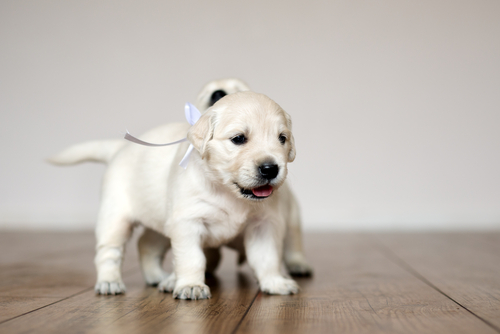Training Your Dog to Walk on Slippery Floors
Published on April 21, 2014

All featured products are chosen at the discretion of the author. However, Vetstreet may make a small affiliate commission if you click through and make a purchase.
Veterinary visits can be stressful for dogs. One of my greatest joys as a trainer lies in teaching dogs to relax and even enjoy the visits, a task best accomplished by minimizing anxiety triggers. Some of the anxiety-provoking situations that occur during visits to the vet are easy to recognize, such as being physically manipulated or receiving immunizations. But other areas of stress are often overlooked, including the fear many dogs have of the slick flooring of the hospital.
Animals can panic when they feel unsteady on their feet, and slippery floors make it challenging to stand, move, stop or stay in one place. For some dogs, a fear of slick flooring may be isolated to the veterinary office or groomer’s, while other canines face their fear daily inside their homes or while out on walks.
Early Exposure
Dogs that are well socialized during their prime learning period — about the first three months — have a better chance of dealing with circumstances they encounter later in life. That may be because the dog dealt with something similar in his puppyhood, such as having had a prior positive experience navigating slippery flooring, and/or he learned that the world is a safe place and he can cope with novel situations when he encounters them.
Though it’s important to socialize a puppy to new situations, including varied flooring, it is possible to help a pooch gain confidence if he missed such early training or already has developed a fear.
Reasons for Fear
In some situations, outside help is warranted. If you are concerned that your dog’s hesitation may be related to a physical impairment or pain, seek veterinary advice. Dogs with conditions like arthritis, for example, are often more hesitant on slick floors because of the pain that occurs when they struggle to stay upright while slipping and the fact that their leg muscles may be weak from disuse.
If your dog is fearful due to his lack of control while walking on a slippery floor, provide him with some traction. Various accessories are available for your dog to wear, from canine booties to disposable paw grips to nail grips. If his fear of slick surfaces is based in the home rather than outside, area rugs provide greater stability on slick floors. In addition, keep nails and fur between paw pads trimmed to make the dog’s paws less prone to slipping.
Training With Rewards
Training can also help a dog relax on slippery floors. Avoid forcing a dog into a situation he is afraid of (i.e., don’t drag him onto a slick floor and hold him there). Such actions come with a high risk of making the fear worse and diminish the trust between person and dog. There are better methods to train a dog than to use force, which can border on being inhumane and increases the risk of aggression in dogs.
Instead, to promote confidence, allow the dog the choice to move onto the floor under his own volition and associate the flooring with rewards.
Food as a Motivator
One method is to allow the dog to gradually become accustomed to the slippery surface during meals. To do so, place his food bowl or stuffed food puzzle that’s stationary (such as a Kong tethered to a table leg) next to the flooring the dog is afraid of. With each meal, position the food slightly farther out on the slick floor, changing the position only by inches and only as the dog remains comfortable enough to eat. Mealtime feeding on the problematic flooring helps the dog become accustomed to the surface and has the added pleasure of associating food with the situation.
You can also get a dog to deliberately move onto the floor while following something he wants. A trail of treats can be streamed across the floor, or the dog can be gradually moved onto the floor with tossed treats for venturing out and a continued stream of treats for staying out on the floor. Play can also be used to improve a dog’s association with the surface and get him used to it. Play a low-key game of tug or a relaxed game of fetch using a soft toy with little bounce to get the dog engaged and move the game slowly out onto the slick floor according to the dog’s comfort level.
On Target
Hand-target training can also give the dog a specific target to focus on to get him to follow you across the floor. Start with your hand just far enough out that one paw touches the floor, eventually building to where all paws are on the floor and the dog moves across the surface to follow your hand. Use the hand target to direct and reward the dog for moving with you. Alternatively, if your dog knows how to heel, ask for a heel and move with him back and forth across the floor, with ample rewards to make the experience feel like a fun game.
Keep in mind, some dogs have extreme fear responses to certain stimuli and advanced behavior modification may be needed. If you need help, seek the advice of a veterinary behaviorist or positive reinforcement trainer working in combination with a veterinarian.
More on Vetstreet.com:





